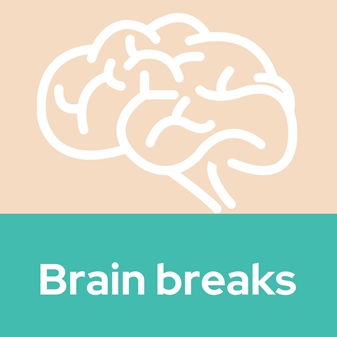Brain breaks for the classroom
What are they and how to use them

Do you find that when you are working on something that requires your focus, you often need to stop and take a brain break? Perhaps you like to take a walk, or a quick 5 minute stretch to help your brain relax and refocus. Research shows that students need these brain breaks too.
Learn how to increase productivity and focus in your classroom!
In this blog post we will teach you:
- What is a brain break?
- Why are they important?
- Examples of brain breaks and how to add them into your lessons.
So, first things first - what is a brain break?
A brain break in the classroom is exactly as it sounds, a break from focused activity to give your students time to relax and refocus. They are usually limited to around 5 minutes and research shows that they work best when combined with some kind of physical activity.
Why are brain breaks so important?
Our brains are always on the go, even during a brain break your students’ brains are processing what they have learned. Breaks keep our brains healthy and play an important role in our cognitive processes such as reading and understanding as well as our ability to formulate original ideas. Brain breaks in the classroom are an essential part of learning!
So, brain breaks help us focus and learn but they have other benefits too. For younger students especially, research has shown that breaks that include physical activity can help reduce disruptive behaviour in the classroom.
Beyond helping your students learn, focus and improving their behaviour in the classroom, regular physical activity is great for your students overall health - and what could be more important than that?
Examples of brain breaks and how to add them into your lessons.
Now you know what a brain break is and why they are important so we are sure that you are keen to discover some examples of brain breaks and how you can use them in your classroom.
Brain breaks do not have to be complicated:
- Bounce it out - your students could pretend they are on an imaginary trampoline, see how many bounces they can do in 1 minute.
- Throw a dance party - have your students pick one of their favourite songs and dance along for 3 minutes.
- Jumping jacks - call out a required number of jumping jacks to get their hearts pumping
- Simple stretches - teach your students some simple yoga stretches to get them moving
- Follow the leader - have one student perform a movement or series of movements and allow the rest of the class to copy, change it up by picking a different student to be the leader each time.
The best time to perform a brain break is before, during and after an activity. For younger students you will probably need to plan a brain break every 5 to 10 minutes into a task, for older students you can plan one for every 20 - 30 minutes. Helpfully, we have built brain breaks into all of our lesson plans.
For more tips, and resources on brain breaks read our hand picked blogs here: Edutopia and Understood.
Or read more blog posts from The English Classroom here and be sure to sign up for our English teaching resources here. We will also send blog posts direct to your email.
Blog written by Rebecca Sparling and posted by Jennifer Gardner